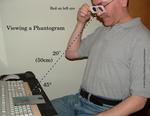 Viewing a Phantogram |
The photos in the following collection are a special kind of stereoscopic (3D) colour anaglyph, called a phantogram (technically, a stereoscopic anamorphosis, also sometimes called a pop-up anaglyph). These particular phantograms were designed to be printed as standard 4x6 inch (A6) prints, such as the kind you can now get for around 25 cents from places like Photolab.ca, among others. To view these, you'll need a pair of red-cyan or red-blue 3D glasses, with the red filter over your left eye. The phantogram prints should be laid flat on a horizontal surface, and viewed at an angle of about 45 degrees, from a distance of about 20 inches (50 cm). (This is called the "sweet spot.") The stereoscopic effect should be quite remarkable, with objects appearing to be standing above the surface of the print. |
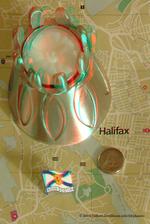 Halifax |
Halifax
One of Canada's oldest cities, capital of Nova Scotia, which is the home of the Bluenose (featured on the Canadian dime), and also home of the finely crafted Seagull Pewter. The pewter candle holder was a gift I received for participating in the CCCI 2004 Bike Tour; the Nova Scotia pin was a souvenir of my trip to Halifax in 2000; the map is from a Halifax visitor guide. This is probably one of my most successful phantograms to date. The 3D effect is quite realistic. The only unfortunate thing is the pin and map have some detail in red, which tends to produce retinal rivalry when viewed with coloured 3D glasses. (It might be possible to reduce that effect by juggling the colour levels, using different anaglyph methods.) This phantogram was included in a Phantogram Exhibit at the Electronic Imaging 2005 Symposium. It's also included in the Guest Gallery of Terry Wilson's web site. |
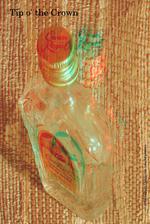 Tip o' the Crown |
Tip o' the Crown
A sample-size bottle of Seagram's Crown Royal Canadian Whiskey. That's it! What else do you need? Because of the height of the bottle, there's a rather drastic divergence between the left- and right-eye images, which might make it difficult to get them to converge. But when they do, the effect is great. (Consider this a sobriety test!) When I view this phantogram, I like to put the actual bottle beside the print. Not only is it interesting to compare the two, but looking at the cap of the real bottle makes it easier to get the images on the print to converge when I shift my focus to the phantom bottle cap. This phantogram was included in a Phantogram Exhibit at the Electronic Imaging 2005 Symposium. |
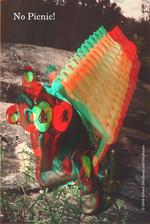 No Picnic! |
No Picnic!
At the end of the day, only a bunch of flowers, and no food in the basket... What's a bear to do? The bear figurine was a gift; I can't remember where I got the basket (but it is actual size). The background is a photo I took at Rainy Lake, of a small cluster of daisies growing in a crack in the rock near the shore. This phantogram was included in a Phantogram Exhibit at the Electronic Imaging 2005 Symposium. |
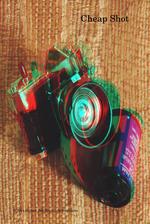 Cheap Shot |
Cheap Shot
A toy camera (actually a small slide viewer) I picked up in Copenhagen, Denmark, and a roll of 35 mm film serve as simple props for this cheap shot. The 3d effect is quite good with this one. |
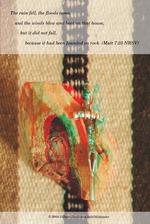 Founded on Rock |
Founded on Rock
The rain fell, the floods came, and the winds blew and beat on that house, but it did not fall, because it had been founded on rock. (Matt 7:25 NRSV) The rock with the icon was a gift from a friend who visited Jerusalem; the crucifix was a gift from the stewardship committee at St. Paul the Apostle Parish. The cloth background is from a Mexican blanket, but I thought its coarse weave had a real old-world look to it. |
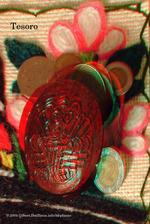 Tesoro |
Tesoro
Treasure, in Spanish. Old cultures mingle in the New World. The coins are from Mexico. The small round case is hand-tooled leather from Peru (a gift from one of my Spanish teachers). The cloth background is from a banner from Colombia (a gift from the Roso family, from Bogota, that I got to know when they spent some time in Winnipeg a few years ago). The banner used a lot of brightly coloured yarn, which was a bit of a problem for the colour separation in the anaglyph. I avoided the sections that used bright red and green, but the pink outlines of the flower petals tend to produce retinal rivalry. The rich red of the leather, brought out by the close, bright lighting, also caused some image ghosting. (I needed bright, direct lighting to bring out the detail of the design.) |
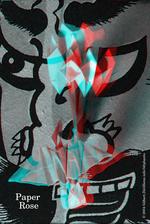 Paper Rose |
Paper Rose
Japan, home of Samurai and origami. The flower is not a rose; the title is a pun, since the paper foldings of the flower and hummingbird rise from the surface. The hummingbird should actually appear to be floating in the air, approaching but not touching the flower. How is this possible? It might help to see the setup that was used. (Note how the hummingbird extends out past the front edge of the target frame, when seen from a side angle, but appears entirely within the frame from the camera's angle.) Unfortunately, the highly contrasting colours of the various objects against the background caused a lot of ghosting, so a black/white anaglyph was made instead. In fact I had to make this one in a special way, using only the blue colour channels of the left- and right-eye images, in order to minimize ghosting. (There's still a bit, but significantly less than in the full-colour version.) It's a shame, since the colours were quite pretty. |
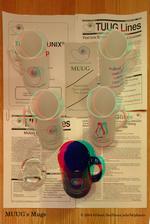 MUUG's Mugs |
MUUG's Mugs
The Manitoba UNIX User Group's history, in a nutshell. A sampling of the group's newsletters over the years, as well as their collectible stuff, like mugs and a paperweight. This is not actual size, unlike all the above items. The actual surface area (for the newsletters) would be 17x22 inches, but the left- and right- eye views use a hyper-stereo base, twice the normal eye spacing. The intention was to reduce this to half size in each dimension, for printing on a standard letter-size page (8.5x11 inches). If this is printed as a 4x6 (A6) print, this reduces the original to about 1/4 size in each dimension. Despite the reduced size and base, the stereo effect is still remarkable. This phantogram was included in a Phantogram Exhibit at the Electronic Imaging 2005 Symposium. |
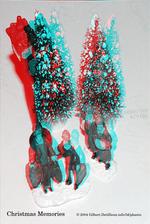 Christmas Memories |
Christmas Memories
A traditional winter street scene... Instant memories of Christmas past. I put this one together very hastily, to demonstrate the process at our family's Christmas gathering. It turned out reasonably well, so I decided to include it in the collection. The figurines were found laid out on top of a piano in the hall we rented. The back of a 4x6 print served as the target frame (surface and measuring guide) for this two-minute phantogram. The figurines had some bright red and green colour, so I used grayscale images to produce the anaglyph. It gives it a more traditional look, I think. |
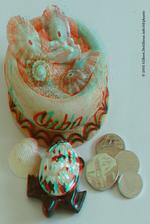 Recuerdos de Cuba |
Recuerdos de Cuba
Memories of Cuba... or Souvenirs of Cuba. The round, wooden jewel box and the turtle were bought at a flea market in Havana. The sand, shells, and coral were collected from the Varadero beach. The coins are of the Cuban "convertible peso" variety, used by tourists. Soft, indirect light (from a window) was used, and the objects themselves didn't have vivid colours, so there were no problems with retinal rivalry. However, there was some ghosting against the solid, light-coloured background. I was able to mostly eliminate that using the Ghost Buster filter in AnaBuilder. This phantogram made the "Good Anaglyph" gallery in the Dabiri Awards 2005 |
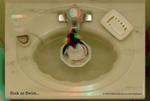 Sink or Swim... |
Sink or Swim...
A very bad pun, but I couldn't resist! The little penguin, so far from his native habitat, ponders whether or not to take the plunge. I wanted to experiment with different levels on this one, with some objects rising above the surface, while others sink (sorry) below. This one is also reduced to about 1/4 of actual size, to print as a 4x6 (A6), and the base may not be exactly right for that size, but it should still work alright. The angle is somewhat steeper than the usual 45 degrees as well: more like around 60 degrees. |
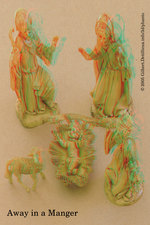 Away in a Manger |
Away in a Manger
A traditional Christmas scene for my 2005 Christmas cards. The figurines were laid out on top of a 8.5x11 inch piece of boxboard. This gave the background a bit of texture, to help conceal ghosting, and also the appearance of sand. (My first thought was to use a piece of sandpaper, but I didn't have one of the appropriate size on hand.) This phantogram made the "Perfect Anaglyph" gallery in the Dabiri Awards 2006 |
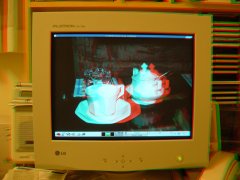 |
If you've enjoyed this collection of phantograms, you might also want to see my Stereoscopic Photo Gallery. |
 |
This work is licensed under a Creative Commons License. Some patents may apply to the process of making phantograms for commercial purposes. |